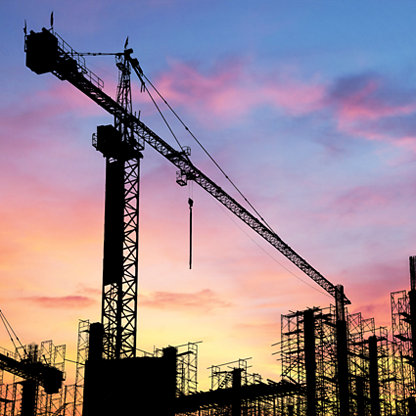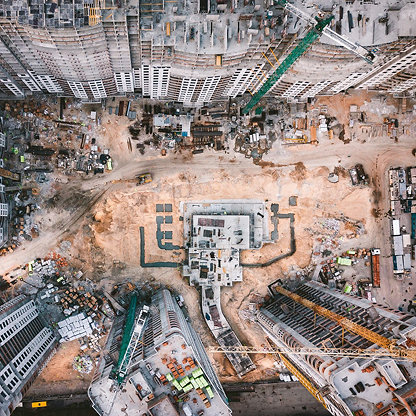How will artificial intelligence improve construction productivity and health and safety while also reducing its environmental impacts? In the second if this three-part series, four industry experts discuss the potential to tackle these ‘wicked’ problems using AI.
Authors
Anil Sawhney FRICS, Head of Sustainability, RICS
Mike Hill, Chief Digital Information Officer, RICS
Jugal Makwana, Senior Executive - Industry Transformation and Strategic/Open Ecosystem, Autodesk
James Garner FRICS, Global Head of Data, Insights and Analytics, Gleeds
Some of the biggest issues that the construction sector must address result from the industry’s ubiquity, scale and complexity. Artificial intelligence (AI) can, by its nature, address complex challenges, based on large data sets that are beyond human capabilities to solve efficiently.
This article highlights the main ‘wicked’ problems the construction industry faces, and examples of how each could benefit from AI. Table 1 explains why these problems are suitable for AI to solve, according to their complexity, additionality, and data availability (as described in part 1).
| Dimension | Reducing environmental impact | Addressing safety and skills shortages |
Improving construction productivity |
| Complexity | Life cycle analysis is complex. Due to the high variability in materials, carbon factors, and supply chains, selecting materials and design options can be difficult. | Safety risks vary across sites, equipment, and workforce conditions. Diverse date sources exist to predict hazards and enhance safety. | Construction workflows involve interdependent tasks and resource constraints. |
| Additionality | Large-scale emissions data and waste patterns are difficult to track manually. | Safety monitoring requires real-time tracking and predicitve insights by integrating workforce data and site analytcis. | Productivity depends on dynamic site conditions and multiple variables. |
| Data availability | Vast datasets from EPDs, carbon conversion factors, and benchmarks. |
Large volume of unstructured real-time data from sensors, cameras, and equipment logs. | A high volume of historical project data, live tracking, and predictive. |
Table 1: Identifying which problems AI should solve
Source: Author’s own.
Reducing the environmental impact of construction
A significant problem for construction is its environmental impact and contribution to the climate crisis. The construction industry is responsible for approximately 40% of global energy and process-related emissions. AI can help address this problem in the following ways:
- Early cost and carbon advice: AI-driven tools, such as Preoptima's Preoptimiser and V-Quest, uses AI to provide live carbon feedback during early design stages, enabling stakeholders to make informed decisions. For instance, if a structural system is changed from concrete to mass timber, the AI backend automates design, material take-offs and carbon calculations. This process delivers actionable results in minutes, allowing real-time scenario testing to optimise costs and carbon emissions. Autodesk’s Forma's embodied carbon analysis provides a machine learning-based prediction that enables users to see the relative impacts of primary materials from the early design stage. Additionally, the Life Cycle Evaluator from BCIS and CostOS from Nomitech, integrates life cycle costs with emissions, offering a comprehensive analysis to support sustainable and cost-effective decision-making with an AI-enabled cost benchmarking backend.
- Optimising material selection: Emidat’s AI platform streamlines the creation and verification of Environmental Product Declarations (EPDs), which are critical for evaluating building materials' environmental impact. Similarly, Pathways simplifies the creation of product life cycle analyses and the generation of EPDs using large language models (LLMs) and supply chain integrations. Firstplanit leverages AI to simplify complex product decisions, seamlessly integrating decarbonisation into design and construction workflows while optimising resource efficiency. By analysing over 200,000 materials, these systems offer insights into variables like water consumption and global warming potential. Automating EPD creation aligns manufacturers with international standards, reducing time, effort and the industry’s carbon footprint.
- Whole life carbon assessment: AI-powered solutions like CarboniCa and One Click LCA measure and reduce whole life carbon emissions in construction projects. CarboniCa is an intelligent tool that automatically identifies and suggests high-carbon building elements and lower-carbon alternatives using machine learning (ML) and AI. One Click LCA automates data integration with its AI Mapping feature, reducing manual effort and enhancing accuracy. Interpreting data variations and learning from user interactions continuously improves whole life carbon assessments. These tools support carbon reduction efforts while ensuring compliance with industry benchmarks and driving cost efficiency. Xylo Systems utilizes AI to analyse and aggregate complex biodiversity data from various sources like camera traps and bioacoustics, allowing them to generate actionable insights and recommendations to measure and manage their environmental impacts.
- Enhancing circular economy practices: Urban Machine leverages AI, computer vision and robotics to advance circular economy practices in construction by focusing on material reuse. The system identifies and processes reusable demolition materials, such as wood, with high precision. AI-powered Qualis Flow complements these efforts by focusing on real-time on-site waste management. Using AI and the Internet of Things (IoT), it tracks and analyses material deliveries, waste production and disposal practices to ensure compliance with sustainability goals. Together, Urban Machine and Qualis Flow demonstrate how AI technologies can transform waste management, advance circular economy practices and minimise environmental impact.
Addressing safety and skills shortage
The construction industry faces two critical, interconnected challenges: ensuring workforce safety, and addressing a persistent skills shortage. These challenges affect productivity, worker well-being and project success. AI provides the following solutions to tackle both issues simultaneously.
- Real-time hazard detection: OpenSpace and REscan use computer vision to capture objects and activities and monitor worksites in real time. OpenSpace systems identify risks, including workers without PPE or hazardous conditions like trip hazards. By capturing and analysing site footage, they enable timely interventions to prevent accidents. REscan enables automatic object finding, which provides contextual information for decision-makers, AI algorithms and robotic applications.
- Predictive analytics: the integration of HammerTech and Kwant uses AI-driven insights and wearable technology to enhance workforce safety and compliance. This system automates daily reporting, monitors safety in real-time and delivers actionable insights to ensure projects remain on schedule and adhere to regulatory standards.
- Automating safety compliance: Saifety.ai, Onwave and Salus are AI-enabled safety management platforms that streamline safety compliance by leveraging artificial intelligence and machine learning. The platform automates the capture, analysis and distribution of safety data, reducing administrative burdens while ensuring consistent compliance with health and safety regulations.
- Addressing skills shortage: AI-driven training programs can personalise learning experiences, using virtual and augmented reality to provide immersive, simulated environments for skill development. AI can also forecast future skill demands through workforce data analysis, enabling strategic hiring and upskilling. By automating repetitive tasks, workers can focus on complex, higher-value activities. AI-powered robotics are transforming labour-intensive construction tasks, addressing the industry's ongoing skills shortage. For example, Rugged Robotics replaces the manual field layout process with autonomous robots that directly mark architectural and engineering designs onto floors, achieving more speed and accuracy. Similarly, Canvas employs a worker-controlled robot with AI and machine vision to finish drywall 1.5 times faster than traditional methods. These advancements help bridge labour gaps while improving productivity and safety.
Improving construction productivity
Productivity in the construction sector has lagged other industries for decades. McKinsey & Company estimated that from 2000 to 2022, global construction productivity improved only 10%, just one-fifth the rate of the overall economy. AI powered tools have the potential to improve productivity and efficiency across the entire project and asset life cycle in the following ways.
- Design automation: Viability is an AI-enabled tool that helps evaluate the sustainability and cost impact of alternative sustainable solutions during the planning, development and appraisal processes. Augmenta generates detailed, code-compliant designs in real-time, reducing manual drafting and speeding up design. By automating repetitive tasks, it enhances accuracy and efficiency. qbiq applies AI to generate and optimise office layouts, improving space use based on project needs. It delivers optimised designs quickly, cutting down traditional design time. These tools accelerate design processes, making construction more efficient and precise.
- AI-powered scheduling and risk management: ALICE and nPlan, can be used to streamline scheduling and risk management. ALICE uses AI to optimise project schedules, identifying potential bottlenecks and suggesting efficient workflows to reduce delays and costs. nPlan applies predictive analytics to analyse past project schedules and assess risks, providing actionable insights to mitigate potential delays and improve delivery certainty. These tools enable proactive and adaptive project planning, enhancing overall efficiency. Document Crunch uses AI and machine learning to simplify complex construction documents, quickly identify critical risks and provide guidance so teams can make informed decisions throughout the project life cycle.
- Decision support and automation: TrunkTools analyses project data to provide actionable insights, helping project managers make informed decisions while automating document retrieval and streamlining workflows. Gryps streamlines document and communication management by extracting key information from contracts, RFIs, and submittals, ensuring critical issues are addressed promptly. These platforms reduce non-value-adding tasks and improve project teams' focus on higher-value activities, leading to greater efficiency and productivity.
- Supply chain management: kayaAI provides live updates on material locations, delivery timelines and equipment status, ensuring that project teams have the resources they need and reducing downtime and delays. Autodesk Construction IQ’s built-in machine learning and AI functionality can predict, prevent and manage cost, schedule, quality and safety risks across the supply chain. BuildHub streamlines supply chain management by simplifying supplier and price discovery, saving contractors time spent searching or calling for quotes. BuiltSpace harnesses AI to optimise construction operations, enhancing efficiency, sustainability and data-driven decision-making.
Conclusion
AI can transform the construction sector, driving progress toward a more sustainable, inclusive and efficient future. But AI also carries certain risks. The third and final article in this series will discuss ways for the industry to capitalise on the benefits of AI while managing risks.
The products mentioned in this article are examples, including some from the RICS Tech Partner program. In most cases, competing products exist that are not listed here. All information is sourced from publicly available materials, and this is not product promotion. Readers should conduct further research as needed.




